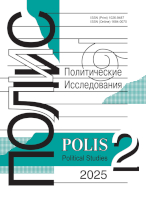Models of Career Trajectories of the Heads of Russian Regions
Barsegyan V.M.,
Senior Researcher, Department of Sociology, Faculty of Social and Behavioral Sciences, Utrecht University, barsegyanwm@gmail.com
elibrary_id: 636790 | ORCID: 0000-0002-4556-9415 |
DOI: 10.17976/jpps/2019.04.10
Barsegyan V.M. Models of Career Trajectories of the Heads of Russian Regions. – Polis. Political Studies. 2019. No. 4. https://doi.org/10.17976/jpps/2019.04.10
The work has been prepared within the framework of the Russian Foundation of Basic Research project No. 17-33-01034 (a2) “Factors of career mobility in political activity in modern Russia”.
This study investigated the models of career trajectories for the acting heads of constituent entities within the Russian Federation, starting from entering the political and administrative sphere in 1991 and ending with the position preceding the governor’s post. The empirical base of the study was biographical information on the 85 heads of the constituent entities of the Russian Federation acting on May 28, 2018. The author developed a method for identifying models of career paths that differ in length and homogeneity. It is shown that the governor’s pool is 60% formed by people from regional elites, represented by deputy governors, chairmen of legislative assemblies; deputies of the State Duma; and heads of cities, including mayors, heads of administrations and their deputies. It was revealed that positions in law enforcement agencies and positions in business structures do not provide direct access to the governor’s seat, but experience in these structures, as well as experience of municipal service, is an important characteristic of the heads of regions. Based on the analysis of career mobility, three types of career trajectory models were identified: 48 short-term dyad models, 25 medium-term triad models, and 4 long-term tetrad models, reflecting career movement patterns of different homogeneity. It was revealed that the level of intergroup professional movements in the short and medium term is relatively low: people mostly move within their spheres, within the same level and branch of government. However, in the long term, intersectoral career mobility increases. This means that there are no stable long-term strategies for reaching the governor’s chair, which can be explained by frequent changes in electoral legislation. In addition, we were able to fix the models of entry of “golden youth” into politics through state and municipal institutions; highly specific models of career trajectories of security forces in civilian agencies and confirm the role of presidential embassies as universal personnel forges for all branches and levels of government.
References
Cotta M., Best H. 2008. Democratic Representation in Europe: Diversity, Change, and Convergence. Oxford; New York: Oxford University Press.
D’Araujo M.C.S., Ribeiro G.L. 2018. Trajetória socioeducacional dos ministros brasileiros na Nova República (1985-2014). – Revista de Sociologia e Politica. No. 26. P. 39-61. https://doi.org/10.1590/1678-987317266503
Gaman-Golutvina O. 2013. Parliamentary Representation and MPs in Russia: Historical Retrospective and Comparative Perspective. – Parliamentary Elites in Central and Eastern Europe. Ed. by E. Semyonova, M. Edinger, H. Best. London: Routledge.
Golosov G.V. 2011. The Regional Roots of Electoral Authoritarianism in Russia. – Europe-Asia Studies. Vol. 63. No. 4. P. 623-639. https://doi.org/10.1080/09668136.2011.566427
Golosov G.V. 2016. Why and How Electoral Systems Matter in Autocracies. – Australian Journal of Political Science. Vol. 51. No. 3. P. 367-385. https://doi.org/10.1080/10361146.2016.1182617
Raadschelders J., Van der Meer F.M. 2014. Administrative Elites in the Netherlands from 1980 to 2011: Making the Invisible Visible. – International Review of Administrative Sciences. Vol. 80. No. 4. P. 726-745. https://doi.org/10.1177/0020852314533454
Scarrow S.E. 1997. Political Career Paths and the European Parliament. – Legislative Studies Quarterly. Vol. 22. No. 2. P. 253-263. https://doi.org/10.2307/440385
Thijssen L., Wolbers M.H.J. 2016. Determinants of Intergenerational Downward Mobility in the Netherlands. – Social Indicators Research. Vol. 128. No. 3. P. 995-1010. https://doi.org/10.1007/s11205-015-1066-7
Van der Meer F.M., Raadschelders J. 2014. Dutch Central Government Elites From 1980 to 2012: Changing Characteristics and Interactions with Political Officeholders. – Revue Francaise d’Administration Publique. Vol. 3-4. No. 151-152. P. 763-782. https://doi.org/10.3917/rfap.151.0763
Weber M. 1978. Bureaucracy. – Economy and Society. An Outline of Interpretive Sociology. Berkley, Los Angeles, London: University of California Press. P. 956-1005.
Barsukova S.Yu. 2013. State and Bandits: A Drama with a Prologue and Epilogue. – Social Sciences and Contemporary World. No. 1. P. 16-26. (In Russ.)
Buckley N., Garifullina G., Reuter J., Frye T. 2013. Politekonomiya vyborov i naznachenii gubernatorov v Rossii [The Political Economy of Russian Gubernatorial Election and Appointment]. Working paper WP1/2013/04. National Research University “Higher School of Economics”. Moscow: Publishing House of the Higher School of Economics. 36 p. (In Russ.)
Degtev A.S. 2016. Russian Political Science Analysis of Government-Business Relations in Russia. – Political Science (RU). No. 2. P. 247-258. (In Russ.)
Dye Th.R., Zeigler H. The Irony of Democracy: An Uncommon Introduction to American Politics. (Russ. ed.: Dye Th.R., Zeigler H. Demokratiya dlya elity. Vvedenie v amerikanskuyu politiku. Moscow: Yuridicheskaya literatura. 320 p.)
Gaman-Golutvina O.V. 2004a. Russia’ Regional Elites: Whom They Consist of, and What Are the Tendencies of Their Evolution (I). – Polis. Political Studies. No. 2. P. 6-19. (In Russ.) https://doi.org/10.17976/jpps/2004.02.02
Gaman-Golutvina O.V. 2004b. Russia’ Regional Elites: Whom They Consist of, and What Are the Tendencies of Their Evolution (II). – Polis. Political Studies. No. 3. P. 22-32. (In Russ.) https://doi.org/10.17976/jpps/2004.03.03
Gaman-Golutvina O.V. 2012. Parlamentskii korpus sovremennoi Rossii [Parliamentary Body in Modern Russia]. – Politicheskii klass v sovremennom obshchestve [Political Class in Modern Society]. Moscow: ROSSPEN. P. 113-142. (In Russ.)
Gimpelson V.E., Magun V.S. 2004. Naim i kar’era molodykh chinovnikov: idei M. Vebera i rossiiskaya real’nost’ [Hiring and Career of Young Officials: the Ideas of M.Weber and the Russian Reality]. – Rossiya reformiruyushchayasya: Ezhegodnik – 2004. Otv. red. L.M. Drobizheva [Russia Reforming: Yearbook – 2004. Ed. by L.M. Drobizheva]. Moscow: Institute of Sociology, Russian Academy of Sciences. P. 125-156. (In Russ.)
Klychnikova K.A., Tregubova E.A., Chirkovskaya E.G. 2018. Career Trajectories of Civil Servants in the Highest Posts of the Public Administration System. – Personality Formation. No. 2. P. 51-55. (In Russ.)
Kryshtanovskaya O.V. 2010. Formats of Russian Power. – Polis. Political Studies. No. 1. P. 27-34. (In Russ.) URL: https://www.politstudies.ru/en/index.php?id=4227&page_id=453
Kurakin A.A. 2013. Career Trajectories of Municipal Servants: Two Types of Professional Mobility (case study in Novgorod Region). – RUDN Journal of Sociology. No. 3. P. 157-169. (In Russ.)
Kynev A.V. 2017. State Duma of the Russian Federation of the VII Convocation: Between “Sleeping Potential” and Party Discipline. – Politeia. Vol. 87. No. 4. P. 65-81. (In Russ.)
Lapina N.Yu. 2014. Political Elite of France in the Beginning of the Xxi Century: Motivations, Career Paths and Vocation. – Power and Elite. Vol. 1. P. 137-160. (In Russ.)
Ledeneva V.Yu. 2006. Business-Elite and Authority in Social Structure of the Russian Society. – Sociology of Power. No. 2. P. 141-149. (In Russ.)
Morozova E.V. 2017. “Politika vrashchayushchikhsya dverei” kak mekhanizm rotatsii elit: sravnitel’no-politologicheskii aspect [“The Policy of Rotating Doors” as a Mechanism for the Rotation of Elites: a Comparative-political Aspect]. – Elity i lidery: strategii formirovaniya v sovremennom universitete [Elites and Leaders: Strategies of Formation in a Modern University. Materials of the International Congress 19-22 April 2017]. Astrakhan: Astrakhan State University Publ. P. 215-216. (In Russ.)
Panov P.V. 2007. Recruiting the Governor in Conditions of Uncertainty: “Permian Case”. – Political Science (RU). No. 2. P. 148-171. (In Russ.)
Sergeev S.A., Zinnatullin A.Z. 2014. Gubernator’s Corpus in 2005-2012: Career Trajectories. – Review of Political Science. No. 4. P. 122-136. (In Russ.)
Tev D.B. 2015. Professional Careers of Senior Regional Officials after Leaving Office. – The Journal of Sociology and Social Anthropology. Vol. XVIII. No. 4. P. 37-52. (In Russ.)
Tev D.B. 2017. Deputies of the State Duma of the VI Convocation: Social-Professional Sources of Recruitment. – Journal of Economic Sociology. Vol. 18. No. 5. P. 52-86. (In Russ.)
Turovsky R.F. 2005. Vlast’ i biznes v regionakh Rossii: sovremennye protsessy obnovleniya regional’noi elity [Power and Business in the Regions of Russia: Modern Processes of Renewal of the Regional Elite]. – Regional’naya elita v Sovremennoi Rossii. Pod red. Ya. Frukhtmanna [Regional Elite in Contemporary Russia. Ed. by Frukhtmann]. Moscow: The Liberal Mission Foundation. P. 143-194. (In Russ.)
Vakhitov R.R. 2017. Estates and Razdatok (Clarifying the Definition of Estates). – Sociological Journal. Vol. 23. No. 4. P. 121-138. (In Russ.) https://doi.org/10.19181/socjour.2017.23.4.5532
Voronkova O.A., Kryshtanovskaya O.V. 2011. Russian Establishment: Ways and Methods of Renewa]. – Polis. Political Studies. No. 1. P. 66-79. (In Russ.) URL: https://www.politstudies.ru/index.php?id=4375&page_id=453
Zarankin I.A. 2016. Theoretical Approaches to Studying Political Actors’ Career Trajectories by the Example of the Fifth and Sixth State Duma Deputies from the “Just Russia” Party. – RUDN Journal of Political Science. No. 1. P. 58-69. (In Russ.)
See also:
Samarkina I.V., Dmitruk S.D.,
Leaders of states after passing the top of their political career: factors, determining roles, and professional trajectories. – Polis. Political Studies. 2011. No1
Kakabadze Sh.Sh.,
Institutionalization of Coordinating the Interests of the RF Subjects: the Changing of Legislation and New Political Realities. – Polis. Political Studies. 2008. No4
Tev D.B.,
Federal Administrative Elite of Russia: Career Paths and Channels of Recruitment. – Polis. Political Studies. 2016. No4
Kozlova N.N., Skakovskaya L.N., Rassadin S.V.,
Youth segment of the deputy corps of regional legislatures of the Russian Federation: socio-professional characteristics, recruitment sources, career trajectories. – Polis. Political Studies. 2023. No1
Lipkin A.I.,
On the «track» of russian history and possibility of a «critical turning point». – Polis. Political Studies. 2012. No1





.jpg)






 print
print
.jpg)
.jpg)